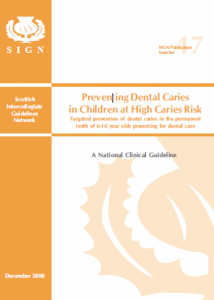 The Scottish Intercollegiate Guidelines Network (SIGN) Guideline No. 47 makes recommendations for the targeted prevention of dental caries in the permanent teeth of 6-16 year olds presenting for dental care.
The Scottish Intercollegiate Guidelines Network (SIGN) Guideline No. 47 makes recommendations for the targeted prevention of dental caries in the permanent teeth of 6-16 year olds presenting for dental care.
The focus on this specific group followed widespread concern about the scale of the caries problem in Scottish teenagers, the uneven distribution of the disease in adolescents, and variations in clinical caries management. Effective targeted prevention of caries in the permanent dentition has great potential to achieve significant health gain, given that once an initial filling is placed a repetitive, costly, lifelong cycle of re-restoration occurs for many individuals. Prevention from age six is important if the first permanent molars are to be adequately protected and should build on preventive programmes for 0-5 year olds. Caries prevention in pre-school children is important but is outwith the remit of this guideline.
This Guideline has been superseded by SIGN 138
Formats
The Guideline and Quick Reference Guide are available to download in Acrobat pdf format (info). Quick Reference Guide (94K) Guideline (461K).
Contents
- Supporting Material for Guideline (not in printed version)
- Key to evidence statements and grades of recommendations
- Guideline development group/li>
- Notes for users of the guideline
- Summary of recommendations
- Introduction
1.1 Background: the need for a guideline
1.2 The Scottish Intercollegiate Guidelines Network
1.3 Remit of the guideline
1.4 Structure of the guideline
1.5 Who is the guideline for? - Definitions and terminology
2.1 Dental caries
2.2 Primary prevention
2.3 Secondary prevention
2.4 Tertiary prevention - Primary prevention of dental caries
3.1 Risk factors for dental caries
3.2 Identifying children at high caries risk
3.3 Behaviour modification in children at high caries risk
3.4 Tooth protection in children at high caries risk> - <Secondary and tertiary prevention
4.1 Diagnosis of dental caries
4.2 Management of carious lesions
4.3 Re-restoration - Information for non-dental professionals
5.1 Dental caries development
5.2 Sugar consumption
5.3 Dry mouth
5.4 Sugar-free medicines
5.5 Children who do not attend a dentist regularly
5.6 Medically compromised
5.7 Orthodontic appliances/li> - Implementing the guideline
6.1 Local adaptation and implementation
6.2 Health service implications of implementation
6.3 Implementation issues for local discussion - Recommendations for audit and research
7.1 Key points for audit
7.2 Recommendations for future research

